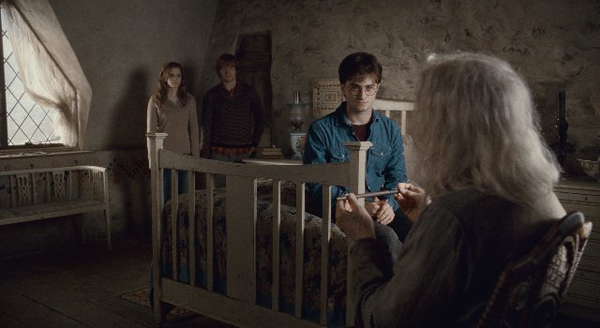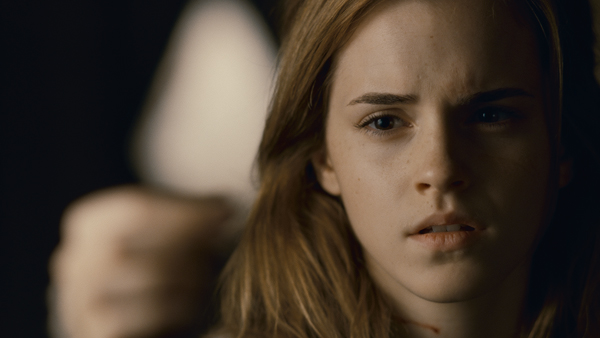‘Harry Potter and the Deathly Hallows Part 2’ is the only film in the Potter franchise to be released
in stereo 3D, although it was not captured stereoscopically. I.E. Effects contributed to the
2D-to-3D conversion, and shared details of their techniques and tools.
 |
|
| A team of about 50 artists at I.E. Effects’ Los Angeles and Traverse City, Michigan, facilities worked together for over six months on the stereoscopic effect, making frame-by-frame adjustments. “The purpose of good 3D is to help tell the story,” said David Kenneth, the company’s founder, working as stereoscopic executive producer for I.E. Effects on this project. "When you get it right, the stereo effect isn’t the focal point. It simply helps the audience become more absorbed in the story.”
Labour Intensive “We received a fairly comprehensive data package from Warner Bros. for our conversion work,” David said. “It included everything we might need. The most helpful for the film’s opening Shell Cottage sequences were the dimensions of the set, and lens information. Using this information to build an accurate 3D model of select areas of the cottage and 3D tracking the frame sequences allowed us to lay in most of the main structure very accurately. Using the depth cues generated by this process allowed us to place additional talent, furniture and props correctly in 3D space.” |
|
 |
|
| In and Out The team handled both interior and exterior shots. “You have to push the 3D a lot more for exterior shots, usually due to the greater distances, so there’s generally a lot more painting," said VFX Supervisor Dennis Michel. "But the interior shots usually have a shallower depth of field, which means more subtle adjustments.” Also, the stereographer and director may decide on a more subtle feel during indoor dialogue sequences, because heavy-handed use of 3D can sometimes detract from an intimate exchange. Several shots in the opening sequence included very fine elements, such as hair blowing in the wind. “The Ollivander character is a wise old wizard with wispy hair,” said Michel. "Hair is an interesting challenge for any kind of visual effects work. For this film we had a small team of artists painting and tweaking individual strands for some time until we got the stereo 3D just right.” Defocused areas of the frame create a different kind of challenge during conversion. If a filmmaker uses a narrow depth of field to draw the viewer's attention to an area in the image, the soft-focus or blurred foreground and background elements have to be handled carefully. The soft-focus parts of the shots need some creative feathering of the depth matte. An artist can manipulate this falloff in order to minimize pulling forward background imagery inappropriately. “Stereo conversion is as much an art as it is a science, so we look at every shot individually and approach it in a handcrafted way,” said Michel. "It is not something for which you can just push a button and let a machine do the work." Shape, Distance, Composition “The shape of an object, as well would dictate the type of depth treatment. A cup, for instance, would fall off into further distance at its sides. This should be represented in the depth build, provided the object is adequately represented in the foreground. Objects that fall within the background of a scene will naturally start falling flat the further their distance from the camera. Sculpting depth across background objects becomes less necessary, and can actually harm the stereo composition if used inappropriately.” Depth Wedges For rotoscoping and reassembling the images, the artists use Nuke combined with their own in-house software to drive the workflow and link the company's two locations. “We use automation to expedite the steps in the process, but this kind of work always comes down to the artist’s eye and a lot of patience. “The values for the depth mattes that we generate are assigned within Nuke using a proprietary I.E. toolset, and we have several other tools in our pipeline to aid the conversion,” David explained. “We utilize 3D packages such as Maya, modo and Lightwave, plus 3D tracking software and other compositing packages that may have specific strengths. But whenever an off-the-shelf tool falls short of our needs, we will try to build a tool to get the results we’re looking for more efficiently.” Dialling Depth The I. E. Effects team worked on several sequences, in particular from the film’s opening scenes at Shell Cottage. David described some of the more interesting shots. “Getting the depth dialled in for the dialogue between Olivander and Harry was challenging and, creatively, also a great deal of fun. For example, manipulating the 3D space in one of the last shots in this sequence allowed us to profoundly enhance the narrative. “As the camera pulls away from Olivander sitting in his chair while Harry and his group are leaving the room, the director required that Olivander feel very alone in the space. To achieve this, we had to exaggerate certain areas of the basic depth, slightly miniaturizing Olivander in effect while making the room feel larger then it was. This made the character feel rather alone and helpless. “Challenges from other sequences involved a very soft focus and rack during an extreme close-up of Hermione, as well as an exterior scene in which Harry examines a shard of mirror.” Here to Stay Instead of coming out of the screen, he feels that good stereoscopy is more subtle and pulls the audience in, making it feel comfortable and natural. “3D is about providing an immersive experience that is as close to real life as you can get in the theatre. It's like 'visual surround sound,' making the story that much more immediate. Just like when movies were given sound, and then colour and then special effects, 3D is a powerful addition to the filmmaker's toolkit when it's used properly.” www.ieeffects.com |
|


















